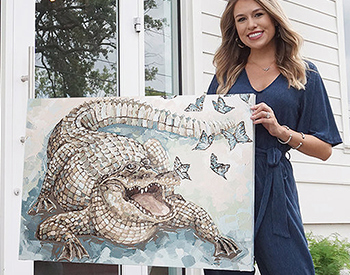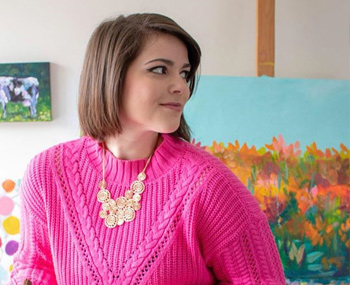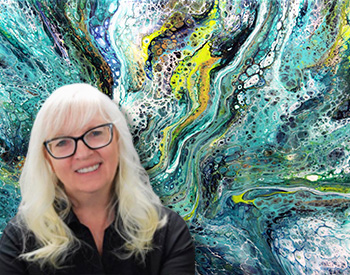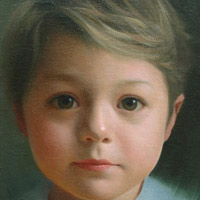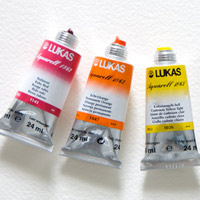Category: Artists
Helpful Tips & Steps To Selling Your Artwork
If there is one question that artists ask all the time, it’s “How much should I charge for my artwork?” It’s as though just knowing the answer to that question will solve all their marketing problems. They are not alone. Here are 4 simple steps to consider when selling your art. We have all done…..
Jerry's -- 20/11/2021
Meet Arizona’s Self-Taught Impressionist Palette Knife Oil Painter
Artist Tessa Nicole Her painting style, techniques and materials Self-taught artist, Tessa Nicole, began painting for the first time in 2015. While it first began as a “new hobby”, she has tirelessly worked her way up to creating full-time and selling her work all around the world working solely with palette knife since January of…..
Jerry's -- 12/08/2020
Making a House Feel Like a Home with Real Art
MEET NEW ORLEANS ARTIST: CASEY LANGTEAU JOHNSON Artist Casey Langteau Johnson has been painting her entire life. She earned her degree in Painting and Drawing from Louisiana State University. Her primary inspiration comes from the natural beauty of her home, New Orleans, Louisiana. However, Casey constantly searches for new ideas abroad, trying to spend as…..
Jerry's -- 31/01/2020
Artist Rachel Christopoulos Reviews Soho Acrylics
Artist Spotlight: Rachel Christopoulos Rachel Christopoulos describes herself as an old soul, coffee addict, and a dreamer (though she’s not the only one). As a Wisconsin native living on the outskirts of Milwaukee, Rachel’s art is constantly being inspired by the energy of the big city. Though she paints a variety of subjects, her artwork…..
Jerry's -- 15/07/2019
Artist 0073.UV Artist Spotlight | Turner Watercolors Review
Artist 0073.UV is a watercolorist and illustrator creating on-trend portraiture in a vivid contemporary pop art palette. Inspired by manga and vaporwave style, 0073.UV regularly posts her work on Instagram and engages daily with her large follower base to educate them about watercolor painting. She creates reproduction prints, holographic prints and stickers of her originals…..
Jerry's -- 04/06/2019
Artist Spotlight – Christina Welch & Soho Artist Acrylics
About Christina Welch Christina Welch is a self-taught mixed media artist originally from Western New York. Currently, she resides in the quaint town of Franklinton, North Carolina. Starting at the age of 4, she was taught crocheting by her grandmother. Since then, she developed a love for the Arts including bead painting, jewelry design, baking, and…..
Jerry's -- 30/11/2018
Artist Rich Pellegrino – Why I Use Turner Acryl Gouache
About Rich Pellegrino Rich Pellegrino’s work is inspired by memories and interpersonal relationships. His figurative paintings are filled with allegory, questioning the authenticity of human experience. He is an award winning illustrator, globally collected fine artist, and a full-time Illustration teacher at New Hampshire Institute of Art. His work can be found in children’s books, magazines,…..
Jerry's -- 24/09/2018
Interview with Professional Artist Andy Russell
Professional Artist Andy Russell shares his techniques and process on how he captures and creates vibrant, colorful & amazingly detailed artwork When I do layering I use either a glazing wash of watered down color or a scumbling technique of rubbing one color over another. Sometimes to get a smooth transition of say, dark green to…..
Jerry's -- 17/08/2018
Painting a Portrait Painting in Oils
Brian Neher is an award-winning portrait artist who has captured the likenesses of clients of all ages. His work has been shown at the Portrait Institute in Manhattan, N.Y., as well as in American Artist magazine. He has received recognition in the National Portrait Competition as well as the West Coast Society of Portrait…..
Jerry's -- 25/07/2018
Go Traveling As An Artist with Lisa Kowieski
Lisa Kowieski – Traveling Artist Materials Used: LUKAS 1862 Aquarell Watercolor Set of 24 Mimik Kolinsky Synthetic Watercolor Brushes Arches 9×12″140 lb. Cold Press Watercolor Block Staedtler Technical Pencils Strathmore 300 Series Mixed Media Sketchbook 5.5×8.5” Last summer I had the opportunity of a lifetime to go on a two week trip to British Columbia,…..
Jerry's -- 08/06/2017
Meet Artist Lisa Marie Kowieski – Artist Spotlight
Lisa Kowieski Multi-disciplinary Artist and Designer from Chicago. “My work is influenced by nature and storytelling with themes of adventure and passion. More than anything, I strive to create work that inspires others to explore their passions and live their best lives. As a multi-disciplinary Artist and Designer, I’m trained in both traditional and digital…..
Jerrys Blog Squad -- 26/05/2016
Drone Art Adventure- Made By Lisa Marie and The Outbound Life
Hey guys I’m Lisa, with Made By Lisa Marie. Art and adventure go hand in hand for me. Last fall, I had the opportunity to explore the Pacific Northwest and make two oil paintings on site of some very famous landscapes. Here’s the catch: my personal assistant for these paintings was a drone (a DJI…..
Jerrys Blog Squad -- 10/05/2016
Why Watercolorists Use LUKAS Aquarell 1862 Artists Watercolors
A Jerry’s Exclusive! – What’s The Buzz! LUKAS, Germany’s best paint makers have made on of our most popular lines of watercolor paints- LUKAS Aquarell 1862 Watercolor Paints. It’s been one of our most popular and best selling watercolors. We thought we’d share the buzz that’s being said since Artists have been clamoring for these…..
Jerrys Blog Squad -- 25/02/2016
Artist Nathalie Kalbach, Artist Spotlight
Nathalie Kalbach is a self-taught mixed media artist. She was born in Germany and lived most of her adult life in Hamburg before moving to the United States in September 2013. She now lives in Jersey City, NJ. Nathalie’s early love of paint was squelched by an art teacher who told her she had no…..
Jerrys Blog Squad -- 20/01/2016
Artist Ron Croci Reviews Da Vinci Pro Panels
Jerry’s Artist Spotlight Artist Ron Croci Is Back With Another Great Art Project 1. The Da Vinci Birch Panel Label. The enclosed tutorial is an explanation of how I have used a Da Vinci, Cradled, Birch panel supplied by Jerrys Artarama to create the art work titled HAMAKUA POKO for the book, THE ATLAS OF…..





